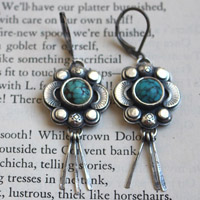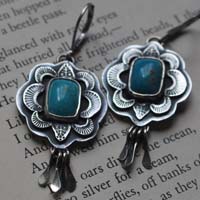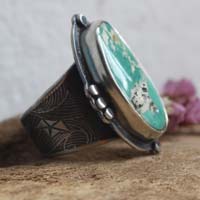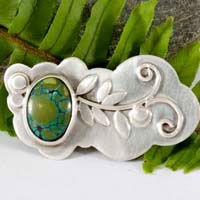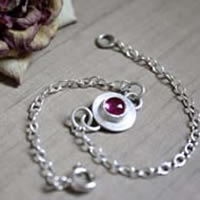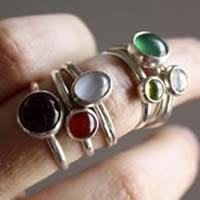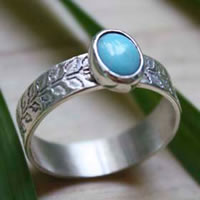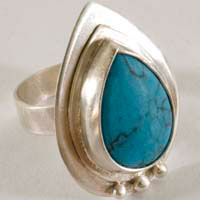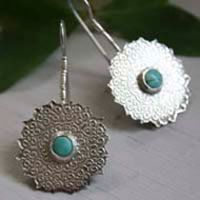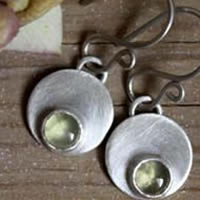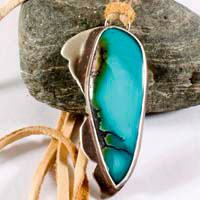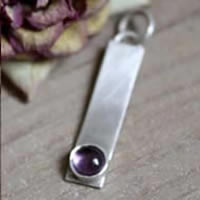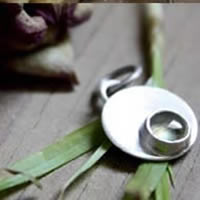- Jewelry
- Inspiration
- Good Deals
- Paintings
- About
- Contact
JEWELRY
- Anklet
- Bracelets
- Brooches
- Cufflinks
- Earrings
- Pendants & Necklaces
- Rings
- Draw your jewelry
- GOOD DEALS
- How to clean your jewel
- Metal we used
INSPIRATION
Turquoise: history, healing properties and lithotherapy

Turquoise properties

Turquoise, a precious gemstone with blue-green hues, derives its name from the French term "pierre turque," dating back to the 16th century. This name refers to the trade route that transported the stone from Persia (modern-day Iran) to Europe via Turkey. Its history is closely tied to the Crusades, a period during which it gained popularity in Europe. However, its use dates back much further, particularly among the Egyptians, Persians, and Native American peoples, who regarded it as a sacred stone.
From a mineralogical perspective, turquoise is a hydrated phosphate of copper and aluminum (CuAl₆(PO₄)₄(OH)₈·4H₂O). Its color ranges from sky blue to green, depending on its copper content (which gives it a blue hue) and iron content (which shifts it towards green). Sometimes, inclusions of limonite or veins of host rock create dark patterns known as "spiderweb," characteristic of certain varieties such as Bisbee turquoise (Arizona) or Tibetan turquoise.
Turquoise is a relatively soft stone, with a hardness of 5 to 6 on the Mohs scale, making it sensitive to impacts, heat, and chemicals. It tends to dehydrate and lose its luster over time if not properly cared for. To enhance its stability and color, some turquoises are treated with resin or wax, a common practice in the jewelry industry.
Its rarity and quality have made it a highly sought-after gemstone for centuries. However, growing demand has led to the introduction of numerous imitations, sometimes difficult to distinguish from genuine stones, even for experts. As early as the Egyptian era, blue silica-based faience substitutes were crafted to replicate its appearance. Today, modern techniques have refined these imitations using various materials:
- Reconstituted turquoise: made by compressing fragments of natural turquoise into a powder and binding them with resin.
- Treated turquoise: a lower-quality stone impregnated with resin or wax to enhance its color and durability.
- Synthetic turquoise: in 1972, Pierre Gilson developed a synthetic turquoise nearly indistinguishable to the naked eye, perfectly replicating the veins and color of natural turquoise. Only chemical analyses can differentiate it.
- Mineral imitations: howlite and magnesite, naturally white and porous, are often dyed blue to mimic turquoise. Other minerals, such as variscite, faustite, or certain types of chalcedony, can be mistaken for turquoise, though their chemical compositions differ.
- Artificial imitations: materials such as plastic, porcelain, or colored glass are also used to imitate turquoise at a lower cost. "Viennese turquoise," for example, is made by compressing aluminum phosphate, while "neolithic turquoise" is a blend of bayerite and copper phosphate.
Experts use various methods to identify genuine turquoise, including magnified examination, acid testing (which reacts differently depending on composition), and spectroscopic analysis in laboratories.
Mines: Tanzania, the USA, Iran, Israel, Turkey, Mexico and China.
History, legends and beliefs about turquoise
Turquoise played a significant role in many ancient cultures. It was revered by Egyptian rulers, the Aztecs and other pre-Columbian civilizations, as well as by the Persians, Mesopotamians, Indians, and Chinese.
Turquoise mining in Iran dates back over 2,000 years. Formerly called "Pirouzeh," meaning "victory" in Persian, it was renamed "Firouzeh" after the Arab conquest. This deposit contains stones of a deep blue hue, though they can turn green when exposed to heat.
In the Persian Empire, turquoise was considered a protective talisman against natural death when worn around the neck or as a bracelet. Belief in its power was so strong that any change in its color was seen as an omen foretelling great misfortune.
Iranian palaces are often adorned with turquoise, symbolizing the sky on earth—an emblematic representation of divine beauty and power.

Since the First Dynasty of the pharaohs, the Egyptians mined turquoise from the Sinai Peninsula, where the stones are characterized by their greenish tones. This precious gemstone was highly prized and used in various objects, particularly those belonging to the nobility. The most famous example is undoubtedly the funerary mask of Tutankhamun, inlaid with turquoise. Its use in religious and funerary objects highlights its significance in ancient Egyptian culture.
Turquoise was associated with Hathor, the Egyptian goddess of love, beauty, music, motherhood, and joy. It was also commonly used in jewelry and amulets, as it was believed to have protective powers and bring good fortune to its wearer.
In antiquity, turquoise also played an important role in Mesopotamia, where it was valued for its protective properties. The Sumerians and Babylonians used it in amulets and royal ornaments, believing it brought divine favor and protection against curses.
Among the Scythians, a nomadic people who roamed the Eurasian steppes in antiquity, turquoise frequently adorned the weapons and jewelry of warriors. It symbolized power and protection, and it was believed to make the wearer stronger and more resilient in battle.
Turquoise reached Europe through Turkey, where it held particular significance for Turkish horsemen, who believed it protected their horses from falls. It was also used as a talisman to safeguard travelers from the dangers of the road.
The Roman scholar Pliny the Elder referred to turquoise as Callais, a name derived from the city of Callaïs in Asia Minor, which was renowned for its turquoise mines.
Turquoise is thought to be one of the stones on the Breastplate of Aaron described in the Bible (Exodus 28), depending on different interpretations. In Jewish tradition, each gemstone on Aaron’s breastplate represents one of the twelve tribes of Israel. Turquoise, associated with the tribe of Zebulun, symbolizes the sea and the sky, evoking divine protection and spiritual guidance.
On the American continent, the Aztecs called turquoise Teoxihuitl. It was used in the creation of numerous ceremonial objects, often in intricate mosaics combining turquoise with gold, quartz, malachite, jade, and coral. Notable artifacts include masks (some built on human skulls), knives, and shields.
In what is now the United States, it is believed that the production of turquoise jewelry, particularly amulets, was a primary craft and economic activity of the Pueblo Indians, especially the Anasazi. The recognized use of turquoise among other tribes, including the Navajo, is thought to date only to around 1880 under European influence.
The Apache and Navajo peoples linked turquoise to Estsanatlehi, the goddess of change, also known as the "Turquoise Woman," who represented the seasons. The Apache believed that if a turquoise stone was attached to a warrior’s bow or rifle, he would never miss his target. For the Lakota Sioux, turquoise was associated with Whope, the goddess of peace. The stone was often used in healing and purification rituals, as it was believed to possess curative and soothing properties.
In Tibet, turquoise holds profound spiritual significance and is one of the "seven treasures" of Tibetan Buddhism. It is frequently embedded in malas (prayer beads) and ritual ornaments. Unlike the deep blue Persian turquoises, Tibetan turquoises are generally veined and greenish, which is especially valued locally. The stone is seen as a symbol of prosperity, health, and protection against misfortune.
Mongolian cultures also revered turquoise, particularly among chiefs and shamans, who wore it as jewelry to invoke the protection of spirits and ensure the prosperity of their clan. Many artifacts from the time of Genghis Khan feature turquoise embellishments.
Turquoise also left its mark on Ottoman culture, particularly in the ornamentation of the sultans’ sabers and daggers. The belief in its protective power was so strong that some warriors embedded the stone directly into the hilt of their weapons.

In Western tradition, turquoise was regarded during the Middle Ages as a protective stone against poison and disease. It was believed to absorb toxins and prevent poisoning, making it highly valued by nobles and alchemists.
In Russia, under the tsars, turquoise was incorporated into numerous crowns and royal ornaments, particularly by Peter the Great and Catherine II. It was associated with luck and the stability of power.
In Europe, turquoise became especially fashionable in the 1800s following archaeological excavations in Egypt, particularly the discovery of Tutankhamun's tomb. This led to a rise in the Neo-Egyptian style in architecture, jewelry, and other decorative arts, bringing the gemstone into the spotlight.
Healing properties and benefits of turquoise
Turquoise is renowned for its healing properties and health benefits. It is associated with physical and emotional balance, promoting overall well-being.
- It is believed to combat eye problems such as eye strain and dryness by improving blood circulation in the eyes and soothing irritations.
- It is also reputed to relieve nasal passages and mucous membranes, helping to clear the sinuses and reduce inflammation, which can be beneficial for those suffering from allergic rhinitis or sinusitis.
- Turquoise is thought to stimulate the heart and throat, enhancing blood circulation and soothing throat irritations. It is particularly connected to the throat chakra, aiding in expression and communication.
- It is also said to dissolve blockages that hinder proper circulation in the body and to reduce inflammation by helping eliminate toxins and accumulated waste from tissues and organs.
- Turquoise is believed to purify the blood, assisting in the removal of toxins and waste, which may benefit individuals with skin conditions such as acne or eczema.
- It is also thought to eliminate body toxins, excess acidity, and gout by aiding in the expulsion of accumulated waste and toxins from tissues and organs.
- Turquoise is said to ease muscle pain and rheumatism by helping to relax muscles and reduce inflammation, making it beneficial for those suffering from joint or muscle pain.
- It is also believed to stimulate the pituitary gland and ward off migraines and headaches by regulating hormones and reducing bodily tension.
- Turquoise is thought to protect the spine, strengthen the bronchi, and help combat arthritis and asthma by reinforcing tissues and organs and improving blood circulation in these areas.
- It also plays a role in regulating bodily fluids and hydrating cells, contributing to overall balance.
- On an emotional level, turquoise is considered a soothing stone, helping to dispel stress, anxiety, and depression. It is often used to boost self-confidence and encourage sincere communication.
- It is also known for protecting against negative energies and harmful external influences. In many traditions, it is regarded as a protective talisman, particularly for travelers.
 Please note that all healing properties presented for gemstones are gathered from various sources. This information is provided as a service and is not intended to treat medical conditions. It is recommended to consult a healthcare professional for serious medical issues and not to rely solely on gemstones as a treatment.
Please note that all healing properties presented for gemstones are gathered from various sources. This information is provided as a service and is not intended to treat medical conditions. It is recommended to consult a healthcare professional for serious medical issues and not to rely solely on gemstones as a treatment.
Turquoise jewelry samples
To learn more about litotherapy, we recommend you the following books:

